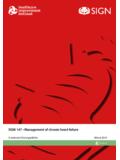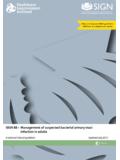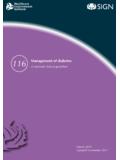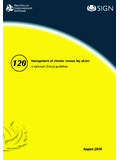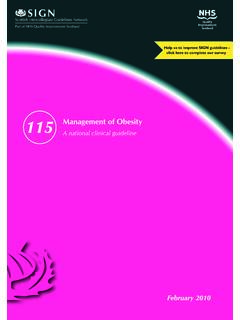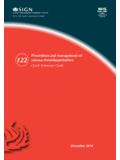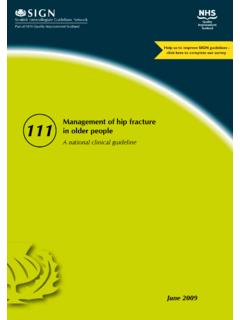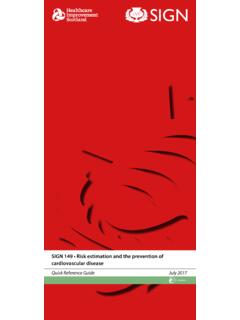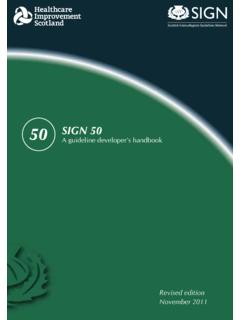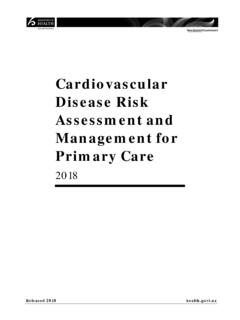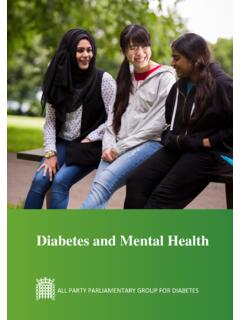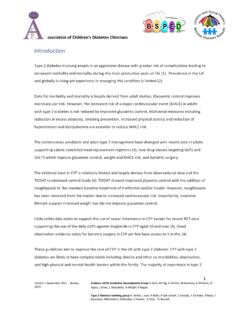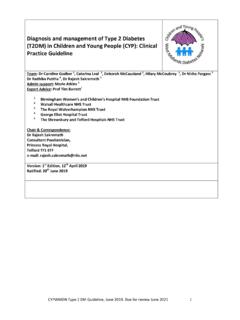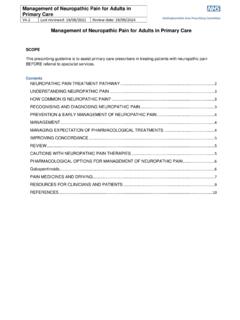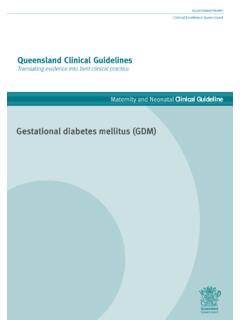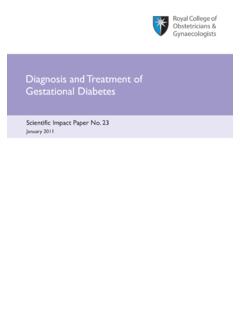Transcription of Quick Reference Guide
1 management of diabetesQuick Reference GuideMarch 2010 Updated November 2017 ISBN 978 1 905813 59 9 Scottish Intercollegiate Guidelines NetworkGyle Square, 1 South Gyle Crescent Edinburgh EH12 management of diabetes Quick Reference Guide 1 ISBN 978 1 905813 59 9 First published March 2010 Reprinted October 2012 Updated November 2017 Scottish Intercollegiate Guidelines Network Gyle Square, 1 South Gyle Crescent Edinburgh EH12 mellitus is a major cause of morbidity and mortality in Scotland and worldwide, with an increasing prevalence. In 2009 there were around 228,000 people with diabetes in Scotland, an increase of from the preceding increase relates, in part, to the increasing age of the population, an increase in obesity and also perhaps increased survival of those with Quick Reference Guide provides a summary of the main recommendations in SIGN guideline 116; management of diabetes and SIGN guideline 154: pharmacological management of glycaemic control in people with type 2 diabetes.
2 Recommendations are arranged in the following sections:Diagnosis and screening2 Lifestyle management3 management of diabetes in pregnancy6 management of diabetic cardiovascular disease8 pharmacological management of glycaemic control in people with type 2 diabetes10 management of type 1 diabetes12 management of kidney disease in diabetes13 Prevention of visual impairment14 management of diabetic foot disease15 Sources of further information17 Conversion table for HbA1c formats18 Recommendations are graded A B C D to indicate the strength of the supporting evidence. Good practice points are provided where the guideline development group wishes to highlight specific aspects of accepted clinical practice. Details of the evidence supporting these recommendations can be found in the full guideline, available on the SIGN website: fromAndroid Market2 management of diabetes Quick Reference Guide management of diabetes Quick Reference Guide 3 WHO criteria for diagnosis of diabetes:The presence of diabetic symptoms (polyuria, polydipsia, and unexplained weight loss) plus fasting plasma glucose (FPG) mmol/l or plasma glucose mmol/l at two hours after a 75g oral glucose load (OGTT).
3 DIAGNOSIS AND SCREENINGS creening recommendationsPSYCHOSOCIALBR egular assessment of a broad range of psychological and behavioural problems in children and adults with type 1 diabetes is recommended. In children this should include eating disorders, behavioural, emotional and family functioning problems. In adults this should include anxiety, depression and eating 1 DIABETESBS creening for pre-type 1 diabetes is not recommended in either the general population or in high risk children and young CONDITIONSCP atients with cystic fibrosis should be screened annually for diabetes from 10 years of people with diabetes should be screened for thyroid and coeliac disease at onset of diabetes and at intervals throughout their At booking all women should be assessed for the presence of risk factors for gestational diabetes. All women with risk factors should have HbA1c or fasting glucose measured. All women with risk factors should have a 75 g OGTT at 24-28 weeks.
4 A fasting plasma glucose at 24-28 weeks is recommended in low-risk DISEASEBACR should be used to screen for diabetic kidney people with diabetes should have ACR tested annually from the age of 12 screening for diabetic retinal disease should be provided for all people with with type 1 diabetes should be screened from age 12 with type 2 diabetes should be screened from with diabetes with no diabetic retinopathy could be screened every two years. All others should be screened at least DISEASEBAll patients with diabetes should be screened to assess their risk of developing a foot MANAGEMENTD elivery of lifestyle interventionsModification of adverse lifestyle factors is an important aspect of the management of all types of diabetes. In particular, appropriate management of cardiovascular risk factors such as smoking, physical inactivity and poor diet is important for the prevention of microvascular and macrovascular lifestyle interventions have been shown to improve self- management , metabolic and psychological outcomes.
5 These include: intensive interventions which include frequent contact with health professionals, telephone contact, multiple injections and self monitoring of blood glucose computer-assisted programmes which provide education and trigger self- management psychological interventions which are varied and include behaviour modification, motivational interviewing, patient empowerment and with diabetes should be offered lifestyle interventions based on a valid theoretical Computer-assisted education packages and telephone prompting should be considered as part of a multidisciplinary lifestyle intervention professionals should receive training in patient-centred interventions in educationEducational interventions for diabetes are complex and varied. Any programme should: have an underpinning philosophy, be evidence based, suit the needs of the individual, have specific aims and learning objectives, and support the development of self- management attitudes, beliefs, knowledge and skills for the learner, their family and carers have a written, structured curriculum which is theory driven, evidence based and resource effective, with supporting materials be delivered by trained educators who have an understanding of the educational theory appropriate to the age and needs of the programme learners be quality assured, reviewed by trained, competent.
6 Independent assessors and assessed against key criteria to ensure sustained consistency have regular audit of programme with type 1 diabetes experiencing problems with hypoglycaemia or who fail to achieve glycaemic targets should have access to structured education programmes based upon adult learning Children and adolescents should have access to programmes of structured education which have a basis in enhancing problem solving with type 2 diabetes should have access to structured education programmes based upon adult learning education programmes should adhere to the principles laid out by the Patient Education Working Group. 4 management of diabetes Quick Reference Guide management of diabetes Quick Reference Guide 5 Psychosocial factors Depression is more common in people with diabetes than in the general population. The presence of micro and macrovascular complications is associated with a higher prevalence of depression and lower quality of life.
7 Remission of depression is often associated with an improvement in glycaemic control. pharmacological (eg antidepressant therapy with a SSRI) and non- pharmacological treatments (eg cognitive behavioural therapy, psychotherapy programmes and coping skills training) have been shown to be effective in diabetic patients with depression and may also improve glycaemic assessment of a broad range of psychological and behavioural problems in children and adults with type 1 diabetes is recommended. In children this should include eating disorders, behavioural, emotional and family functioning problems. In adults this should include anxiety, depression and eating disorders. BHealthcare professionals working with adults and children with diabetes should refer those with significant psychological problems to services or colleagues with expertise in this area. Children and adults with type 1 and type 2 diabetes should be offered psychological interventions (including motivational interviewing, goal setting skills and CBT) to improve glycaemic control in the short and medium Advise all people who smoke to stop and offer support to help facilitate this to minimise cardiovascular and general health risks.
8 Offer intensive management plus pharmacological therapies to people with diabetes who wish to stop smoking. Healthcare professionals should continue to monitor smoking status in all patient monitoring of glycaemiaSmoking cessationWeight management in type 2 diabetesType 2 diabetes is associated with obesity (defined as body mass index >30 kg/m2). Obesity is associated with a significant negative impact on morbidity and mortality. Weight loss in obese individuals has been associated with reductions in mortality, blood pressure, lipid profiles, arthritis-related disability and other outcomes. The SIGN guideline on the management of obesity (SIGN 115) provides detailed recommendations on the prevention and treatment of obesity within the clinical setting, in children, young people and obese adults with type 2 diabetes individualised interventions to encourage weight loss (including lifestyle, pharmacological or surgical interventions) to improve metabolic and physical activityHealthy eating People with type 2 diabetes can be given dietary choices for achieving weight loss that may also improve glycaemic control.
9 Options include simple caloric restriction, reducing fat intake, consumption of carbohydrates with low rather than high glycaemic index, and restricting the total amount of dietary carbohydrate (a minimum of 50 g per day appears safe for up to six months).B Regular physical activity is associated with a reduced risk of development of type 2 diabetes. A rate of perceived exertion scale is useful for estimating exercise intensity. Adults (aged 18 64 years) should build up to achieve a minimum of hours each week of moderate-intensity, or 75 minutes each week of vigorous-intensity aerobic physical activity, or an equivalent combination of both. Aim for 30 minutes of aerobic activity on at least five days of the week. Older adults (aged 65 years and older) should follow the adult guidelines. If this is not possible due to limiting chronic conditions, they should be as physically active as their abilities allow. In people with type 2 diabetes physical activity or exercise should be performed every second or third day to maintain improvements in glycaemic control.
10 In view of insulin adjustments, it may be easier for people with type 1 diabetes to perform physical activity or exercise every people should be advised to increase their level of physical activity to achieve current physical activity recommendations and supported to maintain this level across the and physical activity (involving aerobic and/or resistance exercise) should be performed on a regular about exercise and physical activity should be individually tailored and diabetes specific and should include implications for glucose management and foot advice on avoiding hypoglycaemia when exercising by adjustment of carbohydrate intake, reduction of insulin dose, and choice of injection site, should be given to patients taking with existing complications of diabetes should seek medical review before embarking on exercise gradual introduction and initial low intensity of physical activity with slow progressions in volume and intensity should be recommended for sedentary people with individuals and those at high risk of developing diabetes should be encouraged to reduce this risk by lifestyle changes including weight management and physical interventions aimed at dietary change are more likely to be successful if a psychological approach based on a theoretical framework is with diabetes can take alcohol in moderation as part of a healthy lifestyle but should aim to keep within the target consumption recommended for people without self-monitoring of blood glucose in people with type 2 diabetes is not self-monitoring of urine glucose in people with type 2 diabetes is not of blood glucose is recommended for
